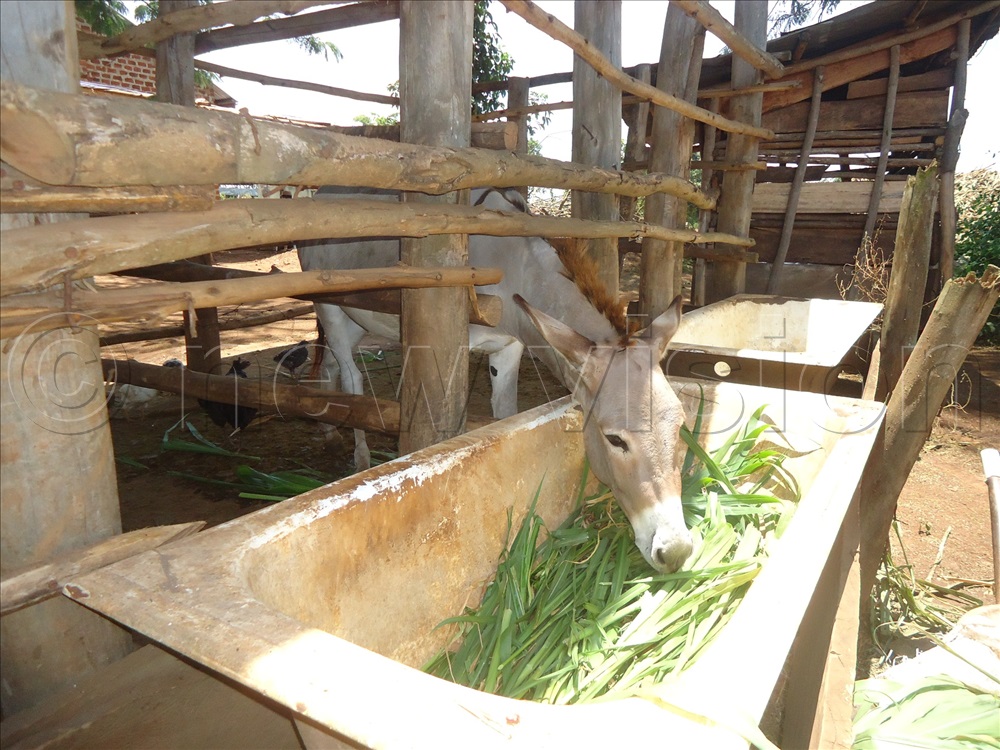By Umar Nsubuga
For many people, a donkey is just an animal yet they are also one of the most interesting farm tools. The donkey is a carrier of goods and farm produce and in some cases can be used for animal traction.
In Uganda, there are a few farms that use donkeys as farm tools. Among these is Shatwa Mixed Farm in Bubajjwe in Kayunga.
It is threatening to rain, forcing Twaha Kakooza who owns the Shatwa Mixed Farm, to race down the rough hilly terrain leading a donkey carrying branches of trees.
His only concern is getting wet and not the means of transport getting stuck in the mostly impassible and muddy roads, across the swampy areas.
“My donkeys can easily move through any terrain. It can climb steep slopes and also travel through impassible paths without any problem”, says Kakooza.

Kakooza, a commercial farmer in Bubajjwe village on Busaana road in Kayunga district says donkey is the most reliable means of transport that can access the area.
He uses his donkeys to carry firewood, water, cow feeds and other kinds of luggage across his farm.
Due to the poor road network in Busaana, donkeys are the commonest means of transport Kakooza uses.
When used for cultivation, it can plough over an acre of land in a day. However, Kakooza says he uses it, together with three bulls, to cultivate over five acres of land in a day.
He adds that it can travel over 100km in 12 hours without getting tired, making it the ideal “beast of burden”.
“It can carry over 150kg of goods and move a distance of about 50km without drinking water. It is an obedient animal that will carry anything without complaining, as long as it is fed well on grass and given water”, he explains.
When you move in Sebei, region donkeys are also bred for income-generation. An adult one costs between sh900,000 and sh1.2m. It can also be hired out to carry luggage and cultivate gardens at sh30,000 an acre.
Kakooza says currently, a big donkey weighing about 100kgs or more is sold for not less than sh1 million.
Feeding
Isaac Malinga, a commercial farmer in Kapchorwa says a donkey must eat food twice its weight and drink a third its weight a day.
Because grass is easily available on the edges of Mt. Elgon National Park, he feeds his donkeys on grass and water on a free range system. The main food is grass, hay, maize stalks or sugarcane stalks. Humans do not drink donkey milk because it is bitter. Its meat is also bitter and red.
Donkeys are drought resistant, efficient, hardworking and easy to maintain. A mature one weighs between 125-150kg. This, however, depends on its age, size, nutrition and health.
A donkey that gets enough rest will carry more loads depending on the gradient of the terrain, speed and the bulkiness of the load. They move faster than oxen and can work for long hours without tiring.
“The average area it can cultivate is 4.5 acres, with just under 0.3 acres cultivated by a single donkey and 4.2 acres by donkey pairs,” Malinga explains.
In Kapchorwa, farm sizes where donkeys are employed in cultivation range from 0.5 to 5 acres and about 80% of the produce is used for subsistence consumption.
Compared to the oxen, a donkey can cultivate 0.5 acres a day while working for five hours. Oxen, on the other hand, can work the same area in four hours, while resting at intervals of 10 minutes every two hours.
According to Kakooza, donkeys are gentle animals that keep their skin smartly clean. They prefer resting under tree shades to wobbling in the mud.
“Unlike a tractor, a donkey can be used in mountainous areas because it cannot easily slip since it is sure-footed”.
According to Simon Chemarum, an official in Suam sub-county, Kapchorwa, a donkey can age without suffering from any illness. Under favourable conditions, this animal can live for over 30 years.
Over 80% of the donkey population in Uganda is employed in agriculture. However, a donkey has to be trained from childhood before performing any task.
“Otherwise it becomes violent when, one day, you attempt to load it”, Chemarum adds.
Giving birth
Kakooza says a donkey takes about 12 months to produce, and it produces one offspring at a time. Twins are rare. The offspring feed on milk for two months before being weaned to hard grass and other foods available.
Characteristics of donkeys
“Donkeys appear to be quite intelligent, cautious, friendly, playful, and eager to learn. A donkey can be called by its owner by a specific name and it comes. It can also tell time by neighing at the top of every hour,” says Kakooza.
“This is how we tell time here, he explains. “It neighs both at night and day time”.
The loud noise also helps it to keep in contact with other donkeys over the wide distances. A donkey’s neigh can be heard over three kilometres away. They also have large ears which pick up distant sounds and may help cool the donkey’s blood.
Donkeys defend themselves through powerful kicks of their hind legs, as well as, biting and striking with the front hooves. Also, a donkey can never allow its offspring to carry luggage when it is not carrying anything itself.
“A donkey has a lifespan of over 20 years. When it dies, it is buried like a human being, or at times, burnt to avoid spread of diseases,” Kakooza explains.
Challenges
Kakooza explains that donkeys sometimes suffer from diseases, such as pneumonia and diet-related diseases that may be difficult to treat due to lack of drugs, or veterinary experts to treat them.





